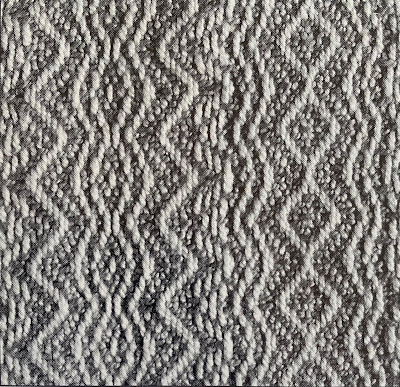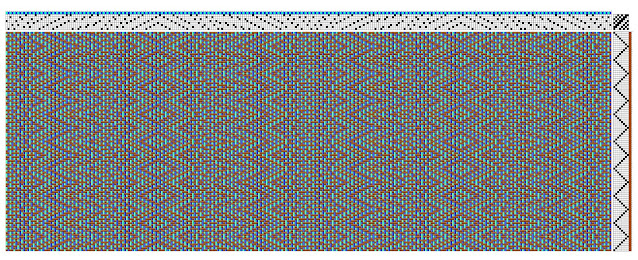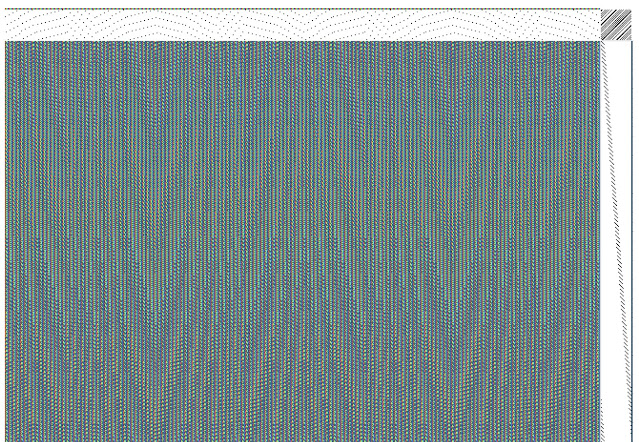 |
Among the 10 or 20 most popular contemporary weaving patterns, Strickler #728 (first photo) is among them, I would guess. I've seen many iterations on Facebook and it never fails to dazzle. And if you "Google" the pattern, the variations go on and on, as you can see in this screen shot from my computer....
Credit goes to Joan McCullough, who designed this intricate, ornate gem -- a Rosepath motif in multiple tabby, which is one of the favorite structures of my "weaving mother," Joyce Robards. (Shout out to Joyce, whose "Many Friends" design appears on the facing page in Strickler.)
It's the endless possibilities for interactions of color and pattern, I believe, that entice most weavers. But for this post, I would like to play with the design potential of #728 using an extended parallel threading, otherwise known as an Echo threading. Once again, McCullough's pattern shines!
The original draft of #728
Above is the original threading, tieup, and treadling you find in Strickler. To create the same pattern in Echo, all you need to do is click on the "Warp" dropdown menu in Fiberworks, choose "Parallel Repeat," then "Overlapping Repeats Shifted by 4," and then "Apply." (Please note that the "Parallel Repeat" command is available only with Fiberworks Silver. Also, I am using a Mac, which has slightly different commands from a PC.)
Here's what you get:
I could see using different-colored stripes in the warp as weavers love to do with the original twill design, so that the linear motifs are outlined and clarified.
What about Jin? Using the same parallel threading, all you need to do is create a 4/4 descending twill tieup and add tabby shots in between. (Note that I changed the weft color to black to emphasize the patterns.)
"Instrestring," as my son used to say when he was a toddler. This may be a bit dizzying, but then again, it all depends on the colors you choose and the function of the piece.
Not much different from Shadow Weave is Rep: same threading, tieup, and treadling. The only changes are that the sett goes from plain weave to denser than double weave and the weft has alternating thick-and-thin yarns.
I like this. Again, I see a lot of potential for playing with different-colored stripes in the warp.
Last, there's double weave, yet another structure that can be designed on an extended parallel threading.
728 in double weave, front
And back, although not much different
McCullough's design comes through in so many variations -- and on just 8 shafts! I got to thinking: I have a 32-shaft Megado, so I wonder what would happen if I expanded the threading to 32 shafts, using a 4-color, 4-end parallel threading?
The way I see it, this pattern is something like Beethoven's Ode to Joy, endlessly pleasing, whether it's performed as a piano solo or with a full symphony and chorus.
And who knows? Maybe I could develop a workshop on this? From Echo to Jin to Shadow Weave to Rep to Double Weave, from 8 shafts all the way to 32...
Thanks for reading!
















6 comments:
This is so interesting. While I don't understand everything you've written here about manipulating a draft, you've put it in my mind that one can indeed manipulate and personalize a draft, allowing for lots of experimentation. Even though I've been weaving for years, I haven't learned to think that way. I need to get better at understanding drafts to pursue this work, so thank you for that challenge!
You're welcome, Ruth! I can't tell you how many hours of study and trial and error I've done with these designs -- and I still know how much more there is to learn.
As to your last line - a workshop.
I would love a workshop on how to take any draft and morph it into all the different structures similar to what you have done with #728.
It could be addicting! Similar to playing a game on the computer! And I can see Kris Bruland running with this idea on Handweaving.net!
If you step back a pace or two, you realize that this is a form of creating fractals, where you go from specific to meta levels. You have to get your mind in the right place to see it!
I am somewhat limited by physical issues that keep popping up, but the mind exercises still keep me engaged. This is such fun!
Actually, Kuelu, I do teach a workshop on this -- two workshops on this, I guess. One is called "One Warp, Many Structures: Explorations in Extended Parallel Threading," in which weavers use one Echo threading and, by changing the tieups and treadlings, weave Jin, Shadow Weave, Rep, and double weave. I teach another course, "Echo and Jin: Variations on a Theme," which explores how you can weave many patterns in Echo, Jin, and double weave using just one parallel threading and, again, varying the tieups and treadlings. This second one gets into color more, as you can weave on a 4-color warp, using a wide chromatic range. And there's lots of color exploration and color theory because the weft colors make such a difference.
Thanks for your comments! I had no idea this was a riff on fractals!
So many possibilities, If one only one had more time to experiment with them all. After taking your workshop Echo and Jin I can wrap my head around what you are doing here. Now to get to the studio to search for appropriate yarns. Thank you!
Barbara, thank you! The bottom line is that, simply by changing the tieup and treadling (or liftplan, if that's the way you like to work) you can achieve endless variations in color, pattern, and structure.
Post a Comment